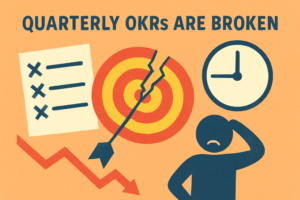The 7 OKR Mistakes That Actually Kill Results
I’ve watched dozens of companies try to implement OKRs over the past few years. Some nail it and see incredible alignment and execution. Others? They turn what should be a powerful strategic tool into bureaucratic theater that makes everyone dread quarterly planning.
The difference isn’t luck, team size, or industry—it’s avoiding these seven mistakes that trip up most organizations when they’re getting started.
1. Tying OKRs to Performance Reviews (The Death Kiss)
This one’s a killer, and I see it everywhere. The moment you connect OKRs to bonuses, promotions, or performance ratings, you’ve fundamentally broken them.
Here’s what happens: Teams start playing it safe. Instead of “Increase market share by 15%,” you get “Increase market share by 2%” because nobody wants to miss their bonus target. Innovation dies, stretch goals disappear, and you end up with the corporate equivalent of participation trophies.
John Doerr warned about this extensively in Measure What Matters, and Christina Wodtke drives the point home in her work on Medium, calling conducting performance reviews based on OKRs the “worst” thing you can do. The folks at Mooncamp are equally blunt: “OKRs and compensation should therefore always remain separate.”
The psychology makes sense. When people’s livelihoods depend on hitting targets, they’ll set targets they know they can hit. That’s human nature, not laziness.
What to do instead: Keep them completely separate. Use OKRs for learning what’s possible, not for deciding who gets promoted. Create a culture where 70% achievement on a stretch goal is celebrated, not penalized.
2. The “Everything is Important” Trap
We’ve all been there. Leadership gets excited about OKRs and suddenly every initiative, every improvement, every nice-to-have feature needs an objective. You end up with 15 OKRs per team and wonder why nothing meaningful gets done.
This completely misses the point. OKRs exist to create focus, not distribute it. When everything’s a priority, nothing is. SugarOKR calls this the “low-value objective” trap, noting that “when too many objectives are set… employees tend to lose focus and become overwhelmed.”
I’ve seen teams cut their objectives from 12 to 3 and immediately see better results. Less really is more. It forces the hard conversations about what actually matters most.
At Xodiac, we built this into our OKR Implementation: Turn Goals into Results with FACTS framework, where Focus is literally the first principle. Without ruthless prioritization, OKRs become noise rather than clarity.
What works: Stick to 3-5 objectives max per team, per quarter. If you can’t fit your priorities in that box, you don’t have priorities—you have a wish list. Force the trade-offs upfront instead of pretending you can do everything.
3. Set It and Forget It
Picture this: Team spends two days in January crafting perfect OKRs. Everyone feels great about the alignment and clarity. Then nobody looks at them until March when someone asks, “Hey, how are we doing on those OKR things?”
Sound familiar? This might be the most common mistake I see.
SimpleOKR puts it well: “Neglecting regular check-ins and progress tracking is a common mistake.” OKRs aren’t a quarterly ritual—they’re a weekly discipline. Without regular reviews, they lose relevance, priorities drift, and course correction becomes impossible.
Think about it: if your strategy can change in a week (and in most companies, it can), why would you check your progress once a quarter?
The fix: Build them into your rhythm. Weekly team meetings, bi-weekly one-on-ones, monthly all-hands reviews—whatever works for your culture. The key is making them a living part of how you operate, not something you dust off when the quarter ends.
4. Confusing Activity with Impact
“Launch the new feature” isn’t a key result—it’s a task on someone’s to-do list. “Improve user engagement” sounds nice but tells you nothing about whether you’re actually winning.
This is where teams get stuck in output-thinking instead of outcome-thinking. Mooncamp warns that “Key Results are often formulated as a checklist of activities… prompting an output-focused approach.”
Real key results measure outcomes, not outputs. They answer “So what?” not just “What?” They connect to business impact, not just team productivity.
Instead of “Complete 5 customer interviews,” try “Reduce churn rate from 8% to 5% based on customer feedback insights.” Instead of “Ship mobile app,” try “Increase daily active users by 25% through mobile engagement.”
We dive deeper into this distinction in our piece on OKRs vs KPIs: What’s the Difference and Why It Matters. The short version: OKRs are for strategic impact, KPIs are for monitoring business health. Mix them up, and you undermine both.
The test: If your key result could be 100% complete but have zero business impact, rewrite it. Your key results should make your CFO happy, not just your project manager.
5. Ignoring the Culture Problem
Here’s what most OKR implementations miss: You can’t just drop this framework into any culture and expect it to work. If your company culture punishes failure, rewards only hitting targets, or operates on fear instead of trust, OKRs will become another way to play it safe.
OKRs need psychological safety. People have to feel okay about ambitious goals that might not hit 100%. They need to trust that a 70% success rate on stretch goals won’t hurt their career.
This isn’t just about process—it’s about changing how your organization fundamentally thinks about goals, failure, and learning. It requires investment in education, coaching, and storytelling to build the right mindset.
I’ve seen companies spend months on OKR training and templates while completely ignoring the cultural shifts required. They end up with beautifully formatted spreadsheets full of safe, boring goals that nobody cares about.
What works: Start with culture first. Celebrate intelligent failures, share stories of successful pivots, and make it clear that the goal is learning, not just hitting numbers.
6. Writing Mushy Key Results
“Improve customer satisfaction.” Great, but improve it how? From what to what? By when? With what measurement?
Vague key results are useless key results. They can’t drive decisions, measure progress, or create accountability. Wikipedia’s entry on OKRs emphasizes this: “Leading indicators… help you course-correct in time—objectives should be clear, actionable, and measurable.”
Compare these:
- Weak: “Improve customer satisfaction”
- Strong: “Increase NPS from 45 to 60 by end of Q4”
- Weak: “Better team collaboration”
- Stong: “Reduce cross-team project delays from 40% to 15% as measured by delivery dashboard”
The second examples actually help you know if you’re winning, and more importantly, they help you know when you need to change course.
The rule: If you can’t put a number on it then it can’t tell you anything about your progress. Every key result needs a metric, a target, and a timeline.
7. Creating Silos Instead of Alignment
Teams write OKRs in isolation, then wonder why they’re stepping on each other’s toes, duplicating work, or optimizing for conflicting outcomes.
This is where most companies miss the real power of OKRs. The magic happens when they’re connected—when the engineering team’s objectives clearly support the product team’s, which obviously connect to the company’s top-line goals.
Without this alignment, you get what I call “local optimization”—every team hits their numbers while the company misses its targets.
Start top-down: Company OKRs first, then cascade down to departments, then teams. Make sure everyone can draw a clear line from their daily work to the bigger picture. Use alignment workshops, cross-team reviews, whatever it takes.
When it works, it’s beautiful. Everyone knows not just what they’re doing, but why it matters.
Making It Work
OKRs aren’t complicated, but they’re not automatic either. They work when you treat them as a living system for focusing your team’s energy on what matters most, not as a quarterly compliance exercise.
The companies that succeed with OKRs understand that it’s not about the format or the software—it’s about building a discipline of regular strategic conversations, honest progress tracking, and continuous course correction.
Skip these seven mistakes, and you’ll avoid the most common pitfalls that turn OKRs from a strategic advantage into expensive busywork. The goal isn’t perfect OKRs—it’s better results. And that starts with getting the basics right.
Ready to dig deeper? Check out Xodiac’s OKR Practitioner Course for step-by-step frameworks, real-world templates, and expert coaching to help your team master strategic execution.




